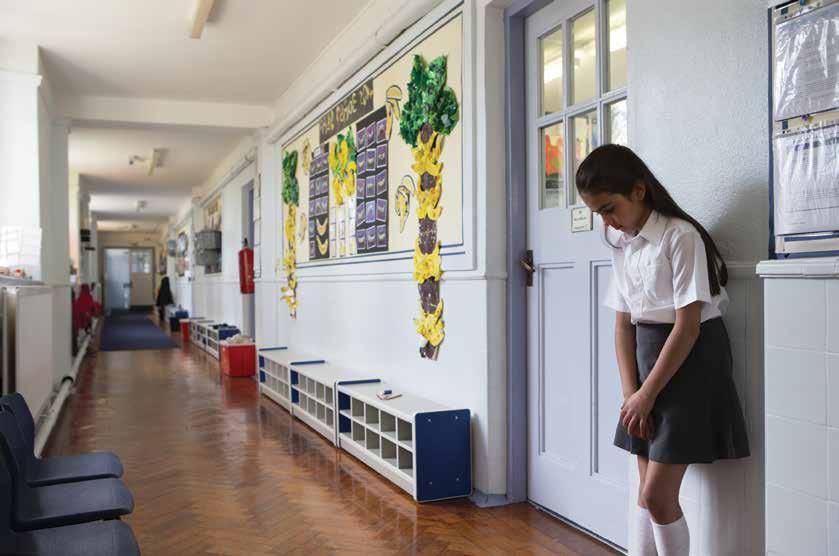
11 minute read
ShOULD SChOOLS EXCLUDE?
There are few things in education as divisive as the school exclusion debate. At what point should a school exclude a student? Ever? debate. At what point should a school exclude a student? Ever? Never? When? What sort of provision should there be for such students and who should provide it? Claire Pass gives her view…
By Claire Pass By Claire Pass
Advertisement


If you’re working in education (and haven’t been on any recent trips to outer space) you’re probably aware of the ‘Great Exclusion Debate’. As with most things to do with education there are passionate opinions, which lead to equally passionate divisions. The problem being that when people feel like they have to defend their position, thinking becomes binary, opportunities to do better are missed and, ultimately, anything involving human interactions, learning, or growth is far too nuanced to be divided into two simple camps.
Although the rate of exclusion has dropped overall, the Timpson Review calls attention to the 60% rise in permanent exclusions between 2015-2020 and the record high of fixed term exclusions in 2018-2019. This is problematic in terms of equality and social justice when we consider that certain groups – males, Black Caribbean, those in care, those from a lower socioeconomic background, SEN students, or those with poor mental health – are more likely to be excluded than others.
A survey by the NHS in 2017 revealed that children in the lowest income quintile were twice as likely to be diagnosed with an emotional disorder as those in the highest earning quintile and during a meeting of the Education Select Committee, Dr Bernadka Dubicka (Chair of the Child and Adolescent Faculty at the Royal College of Psychiatrists) stated that “poverty is a huge driver of mental health problems, probably the biggest driver”. Add to this that the most commonly diagnosed mental health problems are conduct disorders and this all seems to reflect the correlation between poor mental health and exclusion, presented in the Timpson Review.
There has been a pushback against the ‘rhetoric of discipline’ being used by some of those in positions of influence in education, with the argument that sanctions such as seclusion and exclusion can create a vicious cycle of trauma that ultimately leads to societal exclusion. Schools are essentially extra-familial settings that inform a sense of belonging – or lack of belonging. A recent study led by UCL made connections between behaviour and belonging, highlighting that students from disadvantaged backgrounds were twice as likely to say they felt they didn’t belong and four times more likely to be excluded than their more affluent peers.
Exclusion has been revealed to be a critical component of the marginalisation of some young people. If we return to the notion of belonging, it’s not surprising that research both from the 1950s and 2010 concludes that young people who don’t feel they belong to their school community turn to other marginalised peers as sources of support. This indicates that fostering a sense of belonging in education for all

...students from ...students from disadvantaged disadvantaged backgrounds were backgrounds were twice as likely to say twice as likely to say they felt they didn’t they felt they didn’t belong and four times belong and four times more likely to be more likely to be excluded than their excluded than their more a uent peers more a uent peers

is a long-standing issue and alludes to a not too surprising insight: excluded children are more vulnerable to exploitation. There has been much research into the place of exclusion in the ‘school to prison’ pipeline, with conclusions drawn that school discipline policies are a signifi cant mechanism in this process. Although there is clearly a connection between exclusion and criminality, establishing causality is more diffi cult. If you’re excluded at age twelve, you’re four times more likely to be jailed later in life. So does exclusion lead to crime, or is it that if you engage in criminal activity, you’re more likely to be excluded? Empirical fi ndings can only go so far in answering this question as although 90% of young off enders reported that their off ending began before exclusion, research shows an increase in severity and frequency of off ending following exclusion. Whichever side of the debate you are on, it’s evident that we need more information about the mechanisms that can lead already marginalised young people to be excluded from a key site of socialisation. These concerns about the marginalisation of the vulnerable have led to calls for the Education Secretary to reconsider the punitive approach to behaviour issues in schools – just as the government has revised the guidance for exclusions and begun the three-year roll out of behaviour hubs to tackle poor behaviour in schools. Serious transgressions, such as carrying weapons or drugs, have in the past resulted in an automatic permanent exclusion. However, when a child has been coerced or exploited they are a victim of crime, and this approach then becomes problematic. In such situations, it’s been proposed that the government makes updates to statutory guidance so that alternatives to exclusion are sought and the issue can be addressed as a Safeguarding concern. Schools and school leaders are between a rock and a hard place when it comes to the thorny
issue of Safeguarding. This dilemma was neatly illustrated by the NEU’s stance that exclusions be halted post-Covid being hastily revised in instances of sexual assault. The dilemma over the best way to manage behaviour has also taken its toll on teacher mechanism in this process. Although there retention, illustrated by the fact that in the UK in 2018, only 60% of those qualifi ed and criminality, establishing causality is to teach were choosing to do so. Granted, this isn’t entirely down to poor behaviour of pupils but it’s certainly a major factor in many teachers staying away from the classroom. For many years, teachers struggling with behaviour were told to make their lessons more engaging, to be more dynamic, more charismatic. And then there’s the old chestnut ‘well they always behave well for me’. With a fundamental lack of support from some school leaders and a blame culture in operation, for many teachers (and pupils) clear and rigid whole school behaviour systems have been a welcome relief, freeing them to focus on teaching and learning.
more dynamic, more charismatic. And then
Clear and consistent boundaries support students in adjusting to appropriate social boundaries, that could, in the long term, safeguard them from entering the criminal justice system. But undoubtedly far more is needed than sanctions if we are to disrupt the mechanisms in the ‘pipeline’ to exclusion. Some students in vulnerable groups will inevitably fi nd themselves on the wrong side of school boundaries and need support to stay within them, sometimes stretching beyond the remit of the school.
Part of the objection, for those most vehemently opposed to the ‘No More Exclusions’ agenda, is that it expects more of schools than they can off er – school cannot fi x all of society’s ills and despite teachers taking on loco parentis, they can’t truly fulfi l that role of parents and families.
Evidence based parenting programmes have been shown to be an eff ective way of addressing conduct disorders when these are diagnosed. There’s no doubt that how schools engage with (and educate) parents can create what Emma Thomas, CEO of Young Minds, calls an eco-system of support around schools.
But the funding, expertise and capacity to do this needs to be there. There has been an estimated 70% cut to youth services over the last decade and the Children’s Commissioner’s report in January 2021 revealed a huge variation in spending on mental health services, with only 1% of health funding being spent on child mental health (14% less than adults).
A broader range of options for intervention is required if schools are committed to exclusion as a rare last resort, and there needs to be more of it for schools to intervene early and support children preexclusion, as well as having wrap around support for during and post exclusion. The counselling workforce is currently 90% White British, and because the demand on services is too great, children are often told that they are not ill enough to get support (thereby reinforcing stigma). The system of support itself is therefore exclusive. It is also often overlooked that not all children need counselling. In fact, for some children revisiting trauma in counselling sessions can be counter-productive and what they need are interventions that give them the tools to move forward eff ectively.
Is this schools’ problem?
The answer of course is that this is society’s problem, but there’s little doubt that schools can be part of the solution if the issues can be pushed downstream and addressed as early as possible. However, if schools are only partly responsible then the onus should not be solely on them The ‘ecosystem of support’ around schools needs to be a reality that consists not just of families but also of expertise - for example highly trained pastoral teams capable of developing social and emotional learning and building the sense of belonging that could make such a diff erence. Dr Dubicka has suggested that consistently poor behaviour should lead to screening of mental ill health as standard. Drawing on Dr Firmin’s work around Contextual Safeguarding, a school can develop community links within its own context, inviting local sports teams and community groups to provide after school coaching or activities so there is a cohesive sense of joined up support around the young person.
Some of the changes needed require funding, national policy and external agencies, but some can be achieved by the school making eff ective community links and by providing eff ective systems of pastoral support to run alongside behaviour systems.
Good discipline requires that students learn how to behave and are held accountable, but they must also be supported in meeting those behaviour expectations. In some cases, schools also need support, in order to avoid excluding students. But it isn’t always the case that this support exists and there lies the true problem.



FEATURE FEATURE 5 TIPS 5 TIPS

FOR PARENTS AND FOR PARENTS AND CARERS SUPPORTING THEIR CARERS SUPPORTING THEIR CHILD’S LEARNING CHILD’S LEARNING

Parents and carers often struggle with knowing the best way to support their child’s learning and revision. In this article, Kate explains what they can focus on to help their children make better progress. they can focus on to help their children make better progress.


By Kate Jones By Kate Jones



As we head back to school, parents, carers and families will want to know how they can best support their child with their learning. Often, despite being well intentioned, parents can lack knowledge as to what the e ective and ine ective ways of learning and studying are. Below are fi ve evidenceinformed suggestions to share across the wider school community to support families supporting their child’s studying at home.

1. Don’t panic about forgetting

It can be very frustrating when content from lessons is forgotten, for both the teacher and student, but we have come to learn and understand that ‘forgetting is a friend of learning ’ (Bjork and Bjork). Forgetting is an important and natural part of the learning process and an awareness of this can help us to revisit previous content to interrupt and counteract forgetting. However, parents aren’t often aware of this and when their child forgets information they have been taught in school this can cause panic and alarm.

Whilst we don’t need to share with families in-depth knowledge of cognitive psychology, some of the information about how learning happens should be shared, especially when it comes to forgetting. Parents should be reassured that if their child can’t recall something then they need not worry and we can overcome this ( see point 3 as to how this can be achieved).

Parents can become confused when their child hasn’t performed as well as they hoped for on a test or assessment because they watched their child re-reading for hours and saw all their beautifully highlighted and underlined revision notes. What went wrong?
Whilst any revision is better than no revision, there are some strategies research has shown to be more e ective than others. Re-reading, highlighting and underlining are not deemed as the most e ective study strategies, despite being very popular and widely used by students (Dunlosky et al 2013). These methods provide a false sense of confi dence and an illusion of knowing. If parents see their child re-reading and highlighting their notes they should advise them to stop doing so and instead use more e ective study strategies instead.








